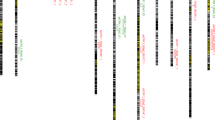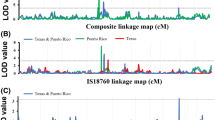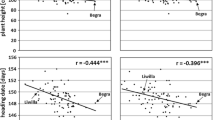Abstract
Anthracnose, caused by Colletotrichum trifolii, is one of the most serious diseases of lucerne worldwide. The disease is managed through deployment of resistant cultivars, but new pathotypes present a challenge to the successful implementation of this strategy. This paper reports the genetic map locations of quantitative trait loci (QTL) for reaction to races 1, 2 and 4 of C. trifolii in a single autotetraploid lucerne clone, designated W126 from the Australian cv. Trifecta. Resistance was mapped in a backcross population of 145 individuals, and reaction was assessed both by spray and injection inoculation of stems. Resistance to injection inoculation with races 1 and 4 was incompletely dominant and closely linked (phenotypic markers 2.2 cM apart); these resistances mapped to a linkage group homologous to Medicago truncatula linkage group 8. When the spray inoculation data were subjected to QTL analysis, the strongest QTL for resistance was located on linkage group 8; six QTL were identified for race 1 and four for race 4. Resistance to race 2 was incompletely recessive; four QTL were identified and these include one QTL on linkage group 4 that was also identified for race 1. Modelling of the interactions between individual QTL and marker effects allowed a total of 52–63% of the phenotypic variation to be described for each of the different races. These markers will have value in breeding lucerne, carrying multiple sources of resistance to the three known races of C. trifolii.



Similar content being viewed by others
References
Ariss JJ, Rhodes LH (2006) A new Colletotrichum trifolii race identified in Ohio. In: North American Alfalfa improvement conference
Barnes DK, Ostazeski SA, Schillinger JA, Hanson CH (1969) Effect of anthracnose (Colletotrichum trifolii) infection on yield, stand and vigor of alfalfa. Crop Sci 9:344–346
Bingham ET, Groose RW, Woodfield DR, Kidwell KK (1994) Complementary gene interactions in alfalfa are greater in autotetraploids than diploids. Crop Sci 34:823–829
Busbice TH (1968) Effects of inbreeding on fertility in Medicago sativa L. Crop Sci 8:231–234
Choi HK, Kim D, Uhm T, Limpens E, Lim H, Mun JH, Kalo P, Varma Penmetsa R, Seres A, Kulikova O, Roe BA, Bisseling T, Kiss GB, Cook DR (2004) A sequence-based genetic map of Medicago truncatula and comparison of marker colinearity with M. sativa. Genetics 166:1463–1502
Churchill ACL, Baker CJ, O’Neill NR, Elgin JH Jnr (1988) Development of Colletotrichum trifolii race 1 and race 2 on alfalfa clones resistant and susceptible to anthracnose. Can J Bot 66:75–81
Clements RJ, Turner JW, Irwin JAG, Langdon PW, Bray RA (1984) Breeding disease resistant, pest resistant lucerne for sub-tropical Queensland. Aust J Exp Agric 24:178–188
Collins HB (1974) The nature and inheritance of anthracnose (Colletotrichum trifolii (Bain and Essary)) resistance in alfalfa. PhD Thesis, Department of Crop Science, North Carolina State University, Raleigh
Cordero JC, Skinner DZ (2002) Isolation from alfalfa of resistance gene analogues containing nucleotide binding sites. Theor Appl Genet 104:1283–1289
Devine TE, Hanson CH, Ostazeski SA, Campbell TA (1971) Selection for resistance to anthracnose (Colletotrichum trifolii (Bain and Essary)) in four alfalfa populations. Crop Sci 11:854–885
Dickman MB, Ha YS, Yang Z, Adams B, Huang C (2003) A protein kinase from Colletotrichum trifolii is induced by plant cutin and is required for appressorium formation. Mol Plant Microbe Ineract 16:411–421
Elgin JH Jr, O’Neill NR (1988) Comparison of genes controlling race 1 anthracnose resistance in Arc-1 and Saranac AR alfalfa. Crop Sci 28:657–659
Elgin JH Jr, Ostazeski SA (1985) Inheritance of resistance to race 1 and race 2 anthracnose in Arc-1 and Saranac AR alfalfa. Crop Sci 25:861–865
Ferrier-Cana E, Geffroy V, Macadre C, Creusot F, Imbert-Bollore P, Sevignac M, Langin T (2003) Characterization of expressed NBS-LRR resistance gene candidates from common bean. Theor Appl Genet 106:251–261
Fox CC, Berberet R, Gray FA, Grau CR, Jessen DL, Petersen MA (1991) Standard tests to characterize alfalfa cultivars, 3rd edn. North American Alfalfa improvement conference
Gallais A (2003) Quantitative genetics and breeding methods in autopolyploid plants. INRA Editions, Paris
Geffroy V, Sevignac M, De Oliveira JCF, Fouilloux G, Skroch P, Thoquet P, Gepts P, Langin T, Dron M (2000) Inheritance of partial resistance against Colletotrichum lindemuthianum in Phaseolus vulgaris and co-localisation of quantitative trait loci with genes involved in specific resistance. Mol Plant Microbe Interact 13:287–296
Grau CR, Arny DC, Nygaard SL (1989) Assessment of alfalfa cultivar reaction to anthracnose in controlled and field environments. Plant Dis 73:167–170
Guy P (1976) Genetic control of tolerance to Colletotrichum trifolii in Medicago sativa L. Ann Amelior Plantes 26:215–534
Irwin JAG (1974) Crown rot of lucerne in Queensland caused by Colletotrichum trifolii. Aust J Exp Ag Anim Husb 14:197–200
Irwin JAG (1977) Factors contributing to poor lucerne persistence in southern Queensland. Aust J Exp Agric 17:998–1003
Irwin JAG, Aitken KS, Mackie JM, Musial JM (2006) Genetic improvement of lucerne for anthracnose (Colletotrichum trifolii) resistance. Australas Plant Path 35:573–579
Irwin JAG, Lloyd DL, Bray RA, Langdon PW (1980) Selection for resistance to Colletotrichum trifolii in the lucerne cultivars Hunter River and Siro Peruvian. Aust J Exp Agric 20:447–451
Lamprecht SC (1986) Reaction of annual Medicago species to Colletotrichum crown rot caused by Colletotrichum trifolii. Phytophylactica 18:183–185
Lenssen AW, Sorensen EL, Posler GL, Stuteville DL (1991). Resistance to anthracnose protects forage quality of alfalfa. Crop Sci 31:147–150
Mackie JM, Irwin JAG (1998) Genetics and race variability of the lucerne-Colletotrichum trifolii pathosystem in Australia. Aust J Agric Res 49:713–722
Mackie JM, Musial JM, O’Neill, Irwin JAG (2003) Pathogenic specialisation within Colletotrichum trifolii in Australia, and lucerne cultivar reactions to all known Australian pathotypes. Aust J Agric Res 54:829–836
Mould MJR, Robb J (1992) The Colletotrichum trifolii—Medicago sativa interface, in culture: a cytological analysis. Can J Bot 70:114–124
Musial JM, Aitken KS, Mackie JM, Irwin JAG (2005) A genetic linkage map in autotetraploid lucerne adapted to northern Australia, and use of the map to identify DNA markers linked to resistance to Phytophthora medicaginis. Aust J Agric Res 56:333–344
Musial JM, Mackie JM, Armour DJ, Phan HTT, Ellwood SE, Aitken KS, Irwin JAG (2007) Identification of QTL for resistance and susceptibility to Stagonospora meliloti in autotetraploid lucerne. Theor Appl Genet. doi:10.1007/s00122-007-0528-y
O’Neill NR (1996) Pathogenic variability and host resistance in the Colletotrichum trifolii/Medicago sativa pathosystem. Plant Dis 80:450–457
O’Neill NR, Bauchan GR (2000) Sources of resistance to anthracnose in the annual Medicago core collection. Plant Dis 84:261–267
Oram RN (1990) Register of Australian herbage plant cultivars, 3rd edn. CSIRO, Melbourne
Ostazeski SA, Elgin JH (1982) Use of hypodermic inoculations of alfalfa for identifying host reactions and races of Colletotrichum trifolii. Crop Sci 22:545–546
Ostazeski SA, Elgin JH, McMurtrey JE (1979) Occurrence of anthracnose on formerly anthracnose-resistant “Arc” alfalfa. Plant Dis Rep 63:734–736
Raynal G (1977) Comparaison, en contaminations artificielles, des pouvoirs pathogenes des Colletotrichum isoles en France sur la luzerne. Ann Phytopathol 9:193–203
Sherriff C, Whelan MJ, Arnold GM, Lafay JF, Brygoo Y, Bailey JA (1994) Ribosomal DNA sequence analysis reveals new species groupings in the genus Colletotrichum. Exp Mycol 18:121–138
Thoquet P, Gherardi M, Journet EP, Kereszt A, Ane JM, Prosperi JM, Huguet T (2002) The molecular genetic linkage map of the model legume Medicago truncatula: an essential tool for comparative legume genomics and the isolation of agronomically important genes. BMC Plant Biol 2:1
Torregrosa C, Cluzet S, Fournier J, Huguet T, Gamas P, Prospéri J-M, Esquerré-Tugayé M-T, Dumas B, Jacquet C (2004) Cytological, genetic, and molecular analysis to characterize compatible and incompatible interactions between Medicago truncatula and Colletotrichum trifolii. Mol Plant Microbe Interact 17:909–920
Welty RE (1982) Forage legume hosts of races 1 and 2 of Colletotrichum trifolii. Plant Dis 66:653–655
You M, Boersma JG, Buirchell BJ, Sweetingham MW, Siddique KHM, Yang H (2005) A PCR-based molecular marker applicable for marker-assisted selection for anthracnose disease resistance in lupin breeding. Cell Mol Biol Lett 10:123–134
Zhu H, Cannon SB, Young ND, Cook DR (2002) Phylogeny and genomic organization of the TIR and non-TIR NBS-LRR resistance gene family in Medicago truncatula. Mol Plant Microbe Interact 15:529–539
Acknowledgments
The authors gratefully acknowledge the Cooperative Research Centre for Tropical Plant Protection, the Australian Research Council (LP0454871) and the Grains Research and Development Corporation (UQ163) for providing funding support for the project.
Author information
Authors and Affiliations
Corresponding author
Additional information
Communicated by J. E. Bradshaw.
Rights and permissions
About this article
Cite this article
Mackie, J.M., Musial, J.M., Armour, D.J. et al. Identification of QTL for reaction to three races of Colletotrichum trifolii and further analysis of inheritance of resistance in autotetraploid lucerne. Theor Appl Genet 114, 1417–1426 (2007). https://doi.org/10.1007/s00122-007-0527-z
Received:
Accepted:
Published:
Issue Date:
DOI: https://doi.org/10.1007/s00122-007-0527-z




